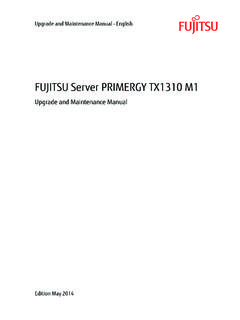Transcription of Transsexualism: An Unacknowledged Endpoint of
1 transsexualism : AN Unacknowledged Endpoint OF DEVELOPMENTAL ENDOCRINE DISRUPTION? by Christine Johnson A Thesis: Essay of Distinction Submitted in partial fulfillment of the requirements for the degree Master of Environmental Studies The Evergreen State College June 22 2004 This Thesis for the Master of Environmental Studies Degree by Christine Johnson has been approved for The Evergreen State College by _____ John Perkins Member of the Faculty _____ Date ABSTRACT transsexualism : An Unacknowledged Endpoint of Developmental Endocrine Disruption? Christine Johnson In recent years, evidence has accumulated demonstrating that endocrine disrupting chemicals (EDCs) have the potential to alter sexual development at the organizational and functional level in many species, including humans, indicating that this class of chemicals may play a role in the etiology of transsexualism .
2 Although transsexualism has historically been attributed to social or psychological causes, little data exists to support these claims, thus requiring a closer examination of the evidence regarding changes in sexual development due to EDCs. Toward that end, this thesis considers data from studies examining hormonal signaling mechanisms and changes in sexual development observed in wildlife, laboratory animals, and humans exposed to EDCs, all providing a consistent picture that sex hormones and their receptors are highly conserved evolutionarily, finding similar effects of disruption in many species. In order to place the data in context, a number of historical threads are examined, including: the use of chemicals in agriculture, the use of the pesticide DDT and the pharmaceutical drug diethylstilbestrol (DES), the intertwined relationship between chemical manufacturers and the military, and the history of transsexualism since 1950.
3 The operation and function of the endocrine system is reviewed in order to provide the background to properly interpret findings from endocrine disruptor studies, focusing particularly on the hypothalamic-pituitary-gonadal (HPG) axis. Recent physiological data regarding the vomeronasal organ (VNO) is reviewed, demonstrating that the VNO is the organ responsible for detecting pheromones, or sexually-relevant chemically-based cues, and that exposure of the VNO to extremely low levels of putative sex hormones causes numerous autonomic system responses, including alterations in endocrine function in males. It is therefore suggested that the VNO plays a central role in the circuitry involving sexual development, and a hypothetical framework for testing this concept is provided. Using this framework, a mechanism for the development of gender identity is proposed, suggesting that gender identity is determined via pheromones by comparing the self with others at an unconscious level.
4 One consequence of this mechanism is that messages conveyed by pheromones can be regarded as signals that can be in contradiction from messages from society, leading to a paradoxical double bind, or a logical contradiction between messages that exist on different logical levels. Another consequence is that there may exist a class of chemicals, pheromone disruptors, that could interfere with pheromones in a manner analogous to endocrine disruptors. Further research must be performed to test this hypothesis since little data exists on pheromones in humans, but early data suggests chemicals may be found that interfere with normal pheromone function. The prevalence of transsexualism is examined, finding that prevalence differences reported in various countries are not well explained by social factors. Also, it is observed that existing studies have reported the prevalence of transsexuals seeking treatment over a specific time period, but this reporting method is not a measure of the number of transsexuals for each country, which is what the term implies to most people.
5 Several recent epidemiological studies that address sexual changes from endocrine disruption are critiqued, finding that they are plagued with methodological weaknesses and contain a number of errors in interpretation. It is argued that instead of using epidemiological techniques, a more useful approach would be to perform demographic studies that map the birthplace of transsexuals in space and time to determine any patterns that may be related to environmental conditions. The lack of detailed data on transsexual demographics, especially in the United States where such data are completely lacking, has left a void where a lack of data has been interpreted incorrectly as a lack of effect. The fundamental assumptions used in risk analysis and toxicology are reviewed in the context of recent findings that the effects of a chemical may be larger at low doses than at high doses and that thresholds for the endocrine system must be determined empirically, rather than by assumption of a dose-response curve and extrapolation from an observed toxicological Endpoint .
6 The use of invalid techniques by toxicologists has thus invalidated claims of chemical safety, and indicates that public policy based on these techniques are insufficiently protective of public health. Because few things are more important to the continuity of cultures than sexuality and social relations, a number of areas requiring further research are identified, and the need for education of the public is emphasized. I conclude that the existing evidence points towards chemical causes of transsexuality rather than social or psychological causes, requiring a shift in research priorities away from psychosocial studies towards physiological studies of transsexuals. Table of Contents Table of Table of 1) The Basic Problem: an Sex and Historical Modern Transsexual 2) Endocrine Disrupting The Endocrine The Vomeronasal Endocrine Receptor 3) Empirical Evidence of Endocrine Experiments with Experiments with Findings in Endocrine Disruption in Other Human 4) Hormones, Sexual Development, and 5) Prevalence of 6) Risk Assessment and Effects of Endocrine Disruption are difficult to Harm due to Endocrine Disruption is difficult to Low Dose Effects of Endocrine Unknown Evaluation of the risk relative to other 7) A New Set of iii Table of Figures Figure 1: Attributes of Sex/Gender located within the body (Left), visible attributes (Middle), and attributes outside and apart from the body (Right).
7 The differences in the dimensions of sex/gender require qualifying terms to specify which dimension of sex is being discussed. See text below for further Figure 2: Plot of gender identity expressed as two continuous variables. A small fraction of genetic males have a gender identity in the range associated with genetic females, and vice Figure 3: Formal dependencies in the development of the gender identity dimension of sex/gender. At each level, predecessors determine the possible outcomes. Other dimensions of sexuality are omitted from flowchart for simplicity. See text for further Figure 4: Milestones and important developmental windows in anatomical sexual development for human genetic males and females. Vertical axis is arbitrary scale. Source: Wilson, et. al., Figure 5: Testosterone concentration for normal genetic male throughout life. Source: Wilson J., Figure 6: A 1918 advertisement suggesting that the fly is a menace to human society, requiring the use of military means to eradicate it.
8 Source: Russell, p. 48, Figure 7: A 1944 advertisement in the journal serving the National Association of Insecticide and Disinfectant Manufacturers, demonstrating the use of military metaphors in insecticide advertising. The equating of human and insect enemies is literal. Source: Russell, p. 121, Figure 8: A 1945 Advertisement from the Chicago Tribune using military metaphors to frame DDT as a new weapon in the war against insects. Source: Henkin, et. al, p. 128, Figure 9: A 1946 United States government poster illustrating that the annihilation of malaria was equated with the eradication of the Japanese, shown in caricature to reduce them to the status of an insect. Source: Russell, p. 133, Figure 10: Annual Pesticide Production in the Unites States from 1954 to 1970. Source: Edwards, p. 2, Figure 11: Persistent Pesticide Production from 1945-1970. Source: Edwards, p. 3, 12: Number of chemicals recommended for EPA testing by the ITC.
9 Source: GAO, Figure 13: Glands of the Endocrine System. Source: Purves et. al. (2003)..46 Figure 14: Detail of hypothalamus and pituitary glands. Source: Purves et. al. (2003).. 46 Figure 15: Anatomical location of the Vomeronasal Organ (VNO). Source: Monti-Bloch, et. al., Figure 16: Reduction in negative affect measured with the Derogatis psychometric test before and after exposure to the pheromone androstadienone. White bars Before exposure, Black bars After exposure. Source: (Monti-Bloch, et. al., 1998)..52 Figure 17: Response of males and females to various pheromones. EVG- Electrovomerogram, -CA alpha cortical activity, -EDA change in skin resistance, -ST change in skin temperature. (* p < ) Source: Monti-Bloch, et. al., iv Figure 18: Neuroendocrine reflex changes in males from exposure to the pheromone pregnadienedione (PDD). (n=10) Source: Monti-Bloch, et. al., Figure 19: Simplified system diagram showing major components involved in the circuitry of gender identity development.
10 Pheromones produced by self are compared to those of others as part of the correlative process of gender Figure 20: Hormone biochemical synthesis pathways showing intermediate products and required enzymes. Planar structure of selected hormones are also shown. Source: White and Speiser ( 2000)..62 Figure 21: Diagram illustrating the regulating behavior of homeostatic systems. Source: World Health Organization, p. 12, Figure 22: Some Receptor-Mediated Mechanisms of Endocrine Disruption. Top left Toxicant binds with receptor initiating hormone production. Top Right Toxicant occupies receptor, blocking normal hormone action. Bottom Co-factors enhance or repress multiple pathways of signaling, resulting in a combined response, each susceptible to interference. Source: McLachlan, Figure 23: Sites of hormone disruption. See text for discussion. Source: World Health Organization, Figure 24: Inverted-U response. Source: Welshons, et.




